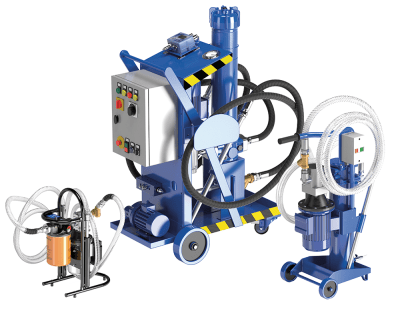
A buyer’s guide to hydraulic filter and lube filter replacements
Fourth Quarter 2022 Hydraulic systems & components
How has the hydraulics market changed? Sourcing of products has become a very erratic and difficult business. Despite technology, buyers are faced with serious challenges to find filter and element replacements, as some older equipment is no longer available in the country. They often find it difficult to identify the product through the brand or product code.
Most hydraulic system manuals recommend that field service personnel replace filter elements according to the operational system specifications with the OEM’s component part. This is identified on the filter element or clearly marked on the housing identification plate. The designated system must be maintained appropriately to obtain optimum operating performance. With ongoing supply chain constraints, production delays and the ever growing need to reduce operating costs, buyers are having to source cheaper replacement elements, and are increasingly sourcing aftermarket replacements due to long lead times from OEMs.
Maintenance engineers first need to investigate the performance output and criteria of the original branded elements and consider the factors below relating to specifications and criteria. When considering the purchase of aftermarket filters and/or elements, equipment maintenance teams must ensure that the original specifications of the system are retained and achieve the specified cleanliness levels. Incorrect filter replacement will seriously affect plant and equipment. Factors to consider are the appropriate design characteristics of the original filter, type of filtering media (efficiency) and micron rating.
Hydrasales specialises in hydraulic and lubrication filtration equipment. Filtering surfaces are separated into two distinct groups that are suitable for a wide range of applications, whether it be return line, suction, inline, low- or high-pressure filters.
Surface filtration
Surface filtration prevents any particles greater than the pore size entering the system by direct intervention. Here the filter media normally comprises metal mesh material, and is used in strainer applications and suction lines, or lube systems where higher contamination levels are acceptable.
Depth filtration
Depth filters are composed of overlapping fibre mats, which form flow paths in various shapes and dimensions. The particles are retained in the pores, which are smaller than the diameter of the particles. During filtering with inorganic fibres (commonly called microfibres), the filter layers are often placed on top of each other to increase the element’s efficiency in arresting and retaining contaminants.
Within depth filtration, system maintenance personnel will commonly be offered two types of media with differing filter efficiencies. The first is commonly referred to as paper or nominal filter cartridge (a single layer of cellulose fibre reinforced with resins). The element may be of the correct micron rating but has lower filtering efficiency. The second, referred to as absolute filter elements, is more sophisticated and may comprise six differing layers of filtering material, including multilayer microfibre, metal mesh, and internal and external support, as well as a PET layer for protection during the installation process.
Buyers are often lured into buying a cellulose paper filter to replace a microfibre element. This is due to the substantially lower price, with the filter having the same micron rating. Lowering the efficiency of a filter will allow for a higher threshold of contamination within the oil. Replacing a microfibre element with a cellulose fibre element can reduce the filtering efficiency by as much as 50%. This can result in frequent breakdowns and higher repair costs as a result of an increase in leaking seals, component failure, and downtime.
Filter beta ratios and efficiencies
Two identically sized filters with the same micron rating can have completely different makeups, and be suitable for very different applications or cleanliness requirements. Filtering elements need to adhere to and be tested in accordance with ISO 16889, Hydraulic Fluid Power – Multi-pass Method for Evaluating Filtration Performance of a Filter Element.
The efficiency of microfibre and paper filtration is measured by the Multipass Test. The beta ratio is the ratio of the number of particles of a maximum given size upstream of the filter to the number of particles of the same size and larger that are found downstream. The higher the beta ratio, the higher the capture efficiency of the filter.
Referring to types of filtering surfaces, a cellulose paper element has a beta 2 ratio with a 50% efficiency, whereas a microfibre element has a 99,9% efficiency, being a 1000 beta ratio. It is imperative to not only look at the micron rating, as it is not possible to evaluate a filter without considering the efficiency or beta ratio at that micron particle size.
Credit(s)
https://motioncontrol.co.za/rss.supplier.aspx?buyersguideid=11&acc=0135&count=all

